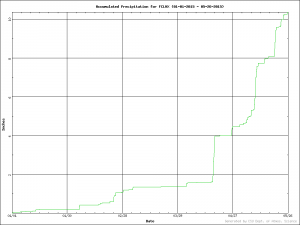News
It’s not normally this wet in Fort Collins, we promise!
To all of our clients who paid CPP a visit in the month of May, we apologize. You came here expecting to enjoy a bit of Colorado’s famous sunshine and perhaps sip a microbrew on one of our many patios. Instead you got soaked in weather that has been more appropriate for hot chocolate than Hefeweizen. Please don’t hold it against us. It’s not normally like this, we promise!
May of 2015 has turned out to be a wet one around here. In a typical year, we’d have received about 6.25 inches of liquid precipitation between January 1 and May 25. This year, nearly as much has fallen in May alone, bringing our year-to-date total to more than 10.5 inches as of May 25. One look at the plot below, courtesy of CSU’s Department of Atmospheric Science, shows just how soggy it’s been in the Choice City.

So let’s set the record straight. Having recently profiled the climates of Singapore and Boston, home to two of CPP’s newest offices, it’s time to take a closer look at the “normal” climate of our own home offices in Fort Collins, Colorado.

Fort Collins enjoys four true seasons, abundant sunshine, and (usually) less precipitation than you might think. Humidity is generally very low, and the Rocky Mountains directly to our west frequently extract the moisture from Pacific storms before they have a chance to deliver rain or snow to the plains. But a curious phenomenon, the so-called upslope storm, reverses the roles, and the plains receive plentiful moisture while mountain locations continue to bask in the sun.
It’s not uncommon to experience major snowstorms in the winter, but snow season here is surprisingly dry. Very cold air often settles in around the end of the calendar year for a couple of weeks, but the coldest of days are frequently accompanied by brilliantly clear skies and direct sunlight that somewhat compensate for the deep freeze.
Spring in Fort Collins is a season of instability that can easily feature snow in the morning and temperatures above 70°F (21°C) by dinnertime. Blizzards occur in March and April with some regularity, but chinook winds often follow quickly, melting the snow in a matter of hours. In late spring, warm weather melts snow high in the mountains and turns normally
quiet streams into rushing torrents. This year’s spring rains have brought abundant moisture that has further contributed to rising rivers and creeks.
Summers can be quite hot, with daytime highs reaching well above 90°F (32°C) and even 100°F (38°C) several times a season. Hot afternoons usually give way to mild nights, with a diurnal temperature swing of as much as 50°F (28°C). In most years, July and August feature the so-called southwest monsoon, in which moisture from the Gulf of Mexico, the Sea of Cortez, and the Pacific Ocean flows into the state, bringing rain and unsettled weather. Southwestern Colorado receives the
brunt of the moisture, but enough makes its way to Fort Collins to deliver exciting, and often severe, afternoon thunderstorms. Up in the mountains, you can almost set your watch by the regularity of these afternoon storms.
Fort Collins autumns are typically very pleasant, with cool, crisp days and cold nights. However, plentiful sunshine and low humidity mean that summertime activities sometimes continue well into November. While Fort Collins itself enjoys remarkably mild falls, just 40 miles (64 km) to the west and a mile (1.6 km) higher in elevation, snow usually begins falling at Cameron Pass in September.
Just in case you don’t believe us, the average monthly climate data for Fort Collins are given below (Source: National Weather Service). And if you came to visit CPP in May, we hope you’ll come see us again soon. Just don’t forget to bring your sunscreen. In all likelihood, you’ll need it.
| Month | Average high | Average low | Average precipitation | Average wind speed |
| January | 44.2°F (6.8°C) | 17.9°F (−7.8°C) | 0.40 in. (10.2 mm) | 6.2 mph (2.8 m/s) |
| February | 46.5°F (8.1°C) | 20.9°F (−6.2°C) | 0.40 in. (10.2 mm) | 7.1 mph (3.2 m/s) |
| March | 54.7°F (12.6°C) | 28.2°F (−2.1°C) | 1.59 in. (40.6 mm) | 7.9 mph (3.5 m/s) |
| April | 62.2°F (16.8°C) | 35.5°F (1.9°C) | 2.06 in. (52.3 mm) | 8.9 mph (4.0 m/s) |
| May | 71.1°F (21.7°C) | 44.5°F (6.9°C) | 2.43 in. (61.7 mm) | 7.6 mph (3.4 m/s) |
| June | 80.4°F (26.9°C) | 52.6°F (11.4°C) | 2.17 in. (55.1 mm) | 7.2 mph (3.2 m/s) |
| July | 86.6°F (30.3°C) | 58.5°F (14.7°C) | 1.71 in. (43.4 mm) | 6.9 mph (3.1 m/s) |
| August | 84.0°F (28.9°C) | 56.7°F (13.7°C) | 1.60 in. (40.6 mm) | 6.7 mph (3.0 m/s) |
| September | 75.9°F (24.4°C) | 47.5°F (8.6°C) | 1.33 in. (33.8 mm) | 6.4 mph (2.9 m/s) |
| October | 63.9°F (17.7°C) | 36.4°F (2.4°C) | 1.15 in. (29.2 mm) | 6.5 mph (2.9 m/s) |
| November | 51.4°F (10.8°C) | 25.9°F (−3.4°C) | 0.76 in. (19.3 mm) | 6.3 mph (2.8 m/s) |
| December | 42.8°F (6.0°C) | 17.7°F (−7.9°C) | 0.50 in. (12.7 mm) | 6.6 mph (3.0 m/s) |
